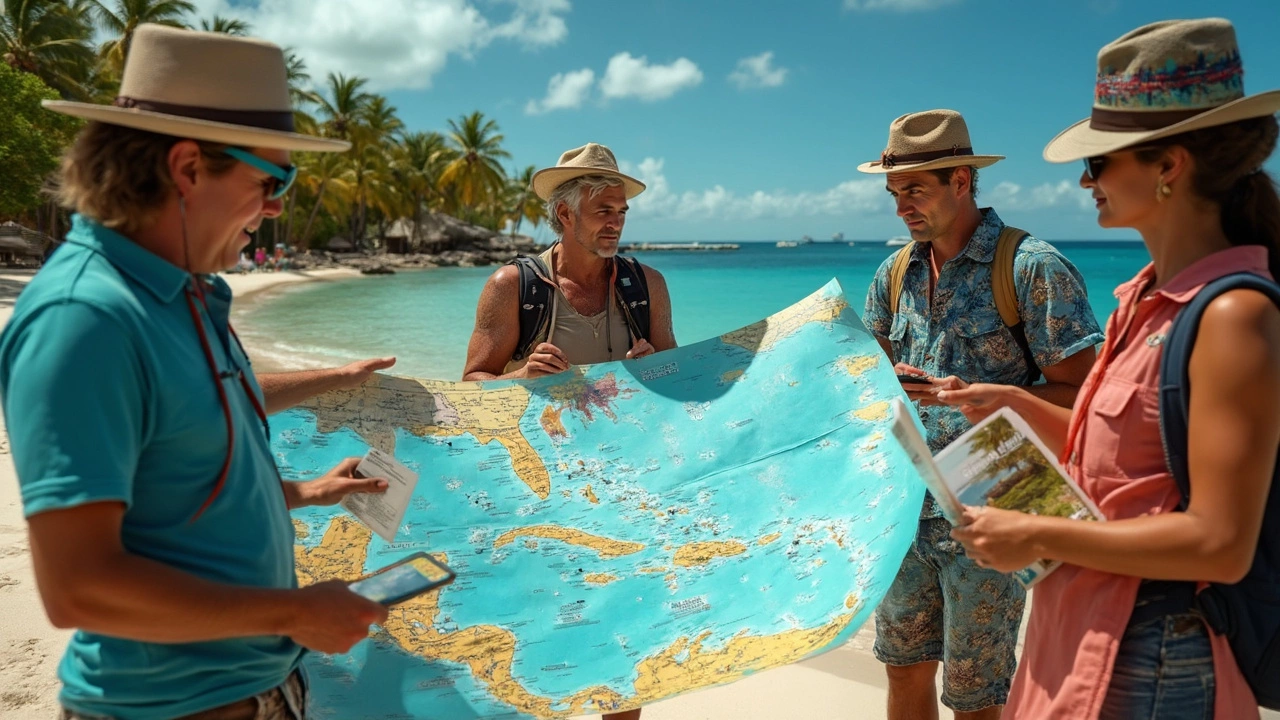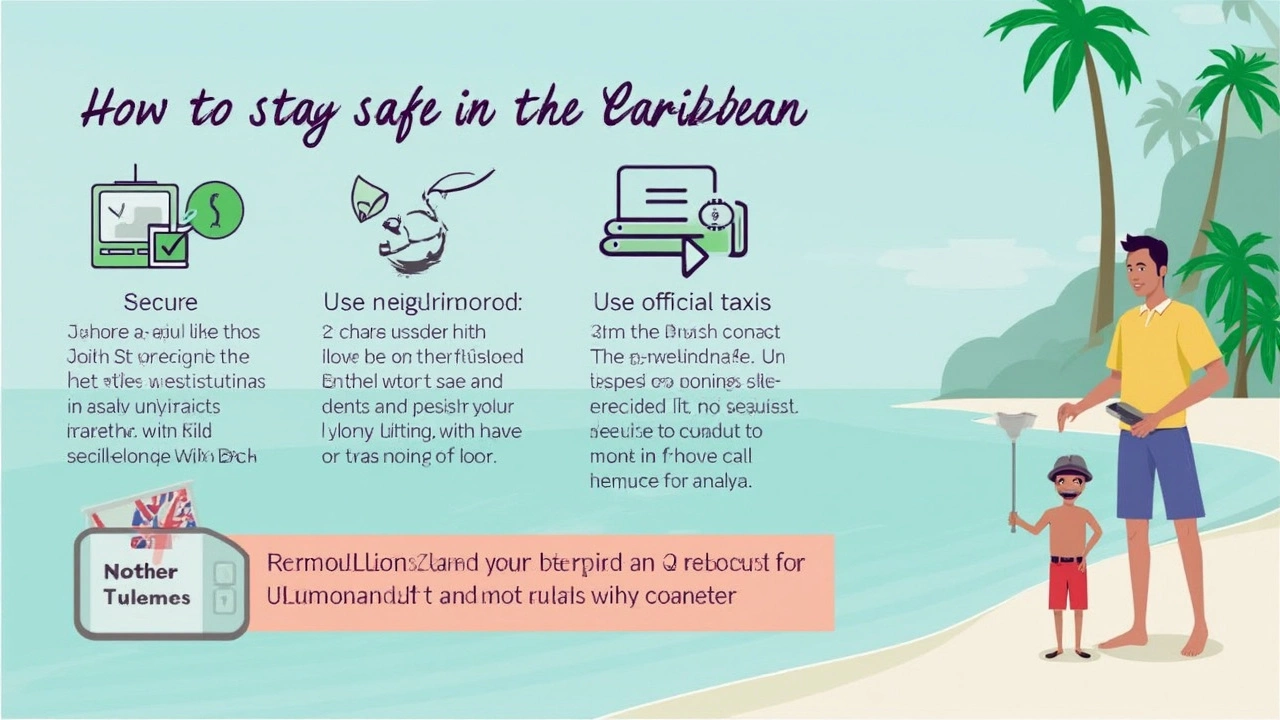Least Safe Caribbean Island: What You Need to Know Before Your Beach Vacation
 Apr, 29 2025
Apr, 29 2025
If you’re scrolling through dreamy photos of Caribbean beaches but find yourself wondering which islands are actually safe, you’re not alone. Too many gorgeous holiday plans go sideways just because folks don’t have the real details. Who wants their vacation ruined by looking over their shoulder all the time?
Let’s be upfront: the Caribbean isn’t all sunshine and cocktails. While spots like Aruba and the Cayman Islands tend to be chill, others have high crime rates that sometimes catch travelers off guard. The goal here isn’t to scare you away, but to help you make smarter choices—so you soak up sun, not drama.
So, which island gets flagged the most for safety concerns? And, more importantly, does that mean you should cross it off your bucket list? This article goes straight into the numbers, real stories, and honest advice, cutting through tourist-brochure fluff. It’ll help you avoid common traps, choose the right beach, and enjoy a real break—with peace of mind.
- Looking at the Numbers: Caribbean Island Crime Rates
- Why Some Islands Face More Danger Than Others
- What the Least Safe Caribbean Island Looks Like
- Common Risks for Beach-Goers and How to Dodge Them
- Smart Travel Tips for Safer Caribbean Holidays
Looking at the Numbers: Caribbean Island Crime Rates
When people talk about the least safe Caribbean island, they’re usually thinking about crime rates. The Caribbean is a huge area, and every country is different, so you can’t paint it all with the same brush. Some spots stay super safe, but others have real trouble with things like theft and violent crime.
Here’s a quick look at recent crime stats (2024) for some well-known islands. These numbers are typically reported by police and pulled together by groups like the United Nations Office on Drugs and Crime and the U.S. State Department. Crime is usually measured by the number of incidents per 100,000 people each year:
| Island/Country | Murder Rate (per 100,000) | Robbery Rate (per 100,000) |
|---|---|---|
| Jamaica | 44 | 68 |
| Trinidad & Tobago | 39 | 77 |
| Bahamas | 27 | 62 |
| Puerto Rico | 16 | 42 |
| Barbados | 12 | 28 |
| Cayman Islands | 3 | 6 |
| Aruba | 2 | 5 |
Jamaica almost always tops the list when folks talk about dangerous Caribbean destinations. The numbers here aren’t padded—they reflect big problems, especially in certain neighborhoods of Kingston and Montego Bay. Trinidad & Tobago isn’t far behind, especially in its capital Port of Spain.
But what does this actually mean for tourists? Most violent crime happens away from resorts, but street robberies, scams, and petty theft do spill over into tourist zones too. The U.S. and U.K. both have travel advisories saying visitors should stay alert, avoid certain areas, and not flash cash or expensive gear.
To put it simply: Some islands, like Aruba and the Cayman Islands, feel almost completely safe, but places like Jamaica and Trinidad need more caution. Knowing these Caribbean travel safety numbers helps you make smarter choices before you book a flight.
Why Some Islands Face More Danger Than Others
The least safe Caribbean island labels don’t show up by accident. It usually comes down to a mix of social, economic, and even political factors. Poverty, limited job opportunities, and a weak justice system often go hand in hand with crime hotspots. Some islands struggle more than others, and this has a direct effect on how comfortable you’ll feel as a tourist.
Let’s get specific. Jamaica and Trinidad & Tobago regularly top the charts for violent crime in the region. Local news and even U.S. Department of State travel advisories point out issues like armed robberies, assaults, and even kidnappings, especially in bigger cities like Kingston and Port of Spain. These areas have higher unemployment rates, a bigger presence of gangs, and less trust in law enforcement—so, crime rates shoot up.
Here’s a quick look at what’s driving the trouble in certain spots:
- Economic hardship: When jobs are hard to find, some turn to quick money through theft or scams targeting tourists.
- Gang activity: Certain islands, especially Jamaica, deal with ongoing gang rivalries. This often leads to violence in neighborhoods where tourists might accidentally wander.
- Police resources: If there aren’t enough cops, or if locals don’t trust the police, criminals act bolder, especially targeting visitors who seem unaware.
- Poor infrastructure: Some islands don’t have enough streetlights, safe public transportation, or secure hotel zones—making it easier for bad stuff to happen without anyone noticing.
- Political instability: While rare, sometimes local protests or political shifts make things unpredictable for travelers, as in Haiti.
Check out how certain islands compare when it comes to crime rates. This table highlights intentional homicide rates per 100,000 people, from recent 2023 data:
| Island | Homicide Rate (per 100,000) |
|---|---|
| Jamaica | 52 |
| Trinidad & Tobago | 39 |
| Bahamas | 30 |
| Barbados | 10 |
| Cayman Islands | 1.5 |
What does this mean for your Caribbean travel safety? The difference is night and day depending on where you go. Busy tourist areas tend to be safer because hotels and resorts pay extra for security, but it pays to know what’s happening in the neighborhoods beyond the resorts.

What the Least Safe Caribbean Island Looks Like
If you check travel warnings and government reports, Jamaica often shows up at the top of lists for the least safe Caribbean island. Don't get me wrong—Jamaica’s beaches are gorgeous and the music scene is famous for a reason. But there’s a real risk factor here, especially in certain parts of the island.
So, what makes Jamaica stand out on the safety front? For one, crime rates are pretty high, especially in big cities like Kingston, Montego Bay, and Spanish Town. We’re talking about violent crimes, including armed robbery, theft, and even some incidents close to popular tourist zones. The U.S. State Department has Jamaica rated with a Level 3 travel advisory, which means “reconsider travel”—that’s pretty serious compared to quieter islands nearby.
If you’re a numbers person, check out this quick comparison. These are 2024 stats pulled from the official police data:
| Island | Intentional Homicide Rate (per 100K) | Travel Advisory Level (2024) |
|---|---|---|
| Jamaica | 43.9 | Level 3: Reconsider Travel |
| Dominican Republic | 11.3 | Level 2: Exercise Increased Caution |
| Bahamas | 29.6 | Level 2: Exercise Increased Caution |
| Barbados | 10.4 | Level 1: Exercise Normal Precautions |
Crime in Jamaica isn’t spread evenly. Areas with big resorts guard their guests pretty well. Trouble’s more likely in some city neighborhoods, especially at night or outside tourist areas. Petty theft—like grabbing bags or pickpocketing—is common at crowded markets and in public buses. But serious stuff, like armed robbery, does happen, and sometimes tourists get caught in the wrong place at the wrong time.
One thing a lot of experienced travelers mention is the hassle factor, too. Aggressive vendors, pushy taxi drivers, and unsolicited guides can make simple outings feel tense. It doesn’t mean you can’t have a fantastic trip, but it does mean being extra aware of your surroundings at all times. Safety isn’t just about numbers—it’s how you handle yourself, where you go, and when you travel.
Key takeaway? If you’re planning a Caribbean beach holiday to Jamaica, it pays to pick safer resort areas, use registered transportation, and avoid wandering off the beaten path—especially after dark. Knowing what to expect goes a lot further than just hoping for the best.
Common Risks for Beach-Goers and How to Dodge Them
Booking a trip to a least safe Caribbean island means you need to watch out for more than sunburn. Crime and safety issues look a bit different here compared to quieter spots like Aruba. In some Caribbean destinations—especially hotspots in Jamaica, the Dominican Republic, and Trinidad—petty crime is way more common in tourist-heavy beach areas. Leave your bag unattended and you might not see it again.
Pickpocketing and bag snatching are the top problems. Thieves know vacationers can be distracted by the beach vibe, so keep your valuables in a waterproof pouch strapped under your clothes, not just tossed in a beach bag. It sounds obvious, but don’t flash cash or expensive jewelry. Locals and guides will tell you: blending in keeps you off the radar.
There’s also a risk of more serious incidents like muggings after dark, especially on empty stretches of sand. Always stick to well-lit, busy beaches and leave before sunset if you’re somewhere new. If you really want a nighttime beach stroll, go with a group and skip showing off your phone or camera.
- Beach alcohol scams: Drinking at local-shack bars is half the fun, but sometimes you’ll get overcharged or worse, served watered-down booze. Check prices first and stick to busier, reputable spots.
- Water safety: Not all Caribbean islands have lifeguards or clear warning signs. Rip currents, especially in places like northern Jamaica, can be sneaky. Pay attention to flags and ask locals about dangerous swim zones.
- Scams and unofficial tours: That friendly guy offering cheap boat rides right on the sand? Not always legit. Book tours through your hotel or reputable agencies.
If you’re curious about how it stacks up, here’s a quick snapshot of reported incidents on some popular but riskier beaches, according to travel advisories and recent reports:
| Beach Area | Common Risk | Safe Time to Visit |
|---|---|---|
| Montego Bay, Jamaica | Bag snatching, scams | Daytime only |
| Piñones, Puerto Rico | Petty theft, car break-ins | Morning/Afternoon |
| Chaguaramas, Trinidad | Muggings, water safety issues | Daytime/with group |
Best bet? Leave your passport and valuables in your hotel safe, not on the sand. Carry just what you need, and stay aware. Trust your gut—if a spot feels sketchy, grab your towel and try another beach. Most locals want you to have a good time, but it pays to play it safe when you’re visiting a dangerous Caribbean destination.

Smart Travel Tips for Safer Caribbean Holidays
Don’t let reports about the least safe Caribbean island freak you out completely. Most travelers visit the region without running into trouble, but you can boost your odds by following some of these down-to-earth tips. A beach holiday should actually be relaxing, not nerve-wracking.
- Pick Your Stay Wisely: Stick with well-reviewed hotels or resorts in busy, tourist-friendly areas. Gated resorts or big brand chain hotels tend to offer more security and fewer hassles than a cheap, mystery Airbnb in a rough part of town. Look at recent guest reviews—if people mention safety issues, don’t ignore them.
- Know Where Not to Go: Every island has some areas you honestly just shouldn’t visit after dark (and sometimes not at all). Your hotel staff or a local guide can tell you which neighborhoods to avoid. And it’s not just about violent crime—some parts get more petty theft, so keep your beach bag in sight.
- Blending In: Leave the flashy jewelry, designer bags, and expensive gadgets in your hotel safe. Walking around with obvious wealth just paints a target. Grab a simple tote and dress casual—don’t worry, no one’s expecting you to dress up at the beach.
- Money Moves: Carry only what cash you need for the day and stash a backup credit card somewhere safe. ATMs inside banks or hotels are safer than random ones on the street. Also, if possible, pay in local currency—exchange rates at beach bars can be straight-up robbery.
- Transportation Smarts: Skip the random taxis. Use authorized cabs, hotel shuttles, or ride apps if they’re available. If you rent a car, keep all valuables locked up or out of sight when you’re parked at a beach.
Here’s a quick table so you can spot some common risks in the least safe Caribbean island compared to two of the safer ones:
| Island | Reported Robbery Rate* | Common Tourist Issue | Safe Travel Rating** |
|---|---|---|---|
| Jamaica | 47 per 100,000 residents | Scam tours, street theft | Medium-Low |
| Cayman Islands | 2 per 100,000 residents | Lost property | High |
| Aruba | 3 per 100,000 residents | Minor theft (rare) | High |
*Recent police data, 2023; **Based on travel advisories
Trust your gut while wandering around. If a street or area has zero tourists and looks sketchy, just turn back. Keep your phone charged, save your hotel number, and let someone reliable know where you’re going—especially if you’re venturing off the resort for the day.
One last thing—don’t post live vacation updates with location tags. This sounds techy, but a few robberies have happened after tourists advertised their whereabouts in real time. Post your killer beach pics after you’ve already left.
